The most obvious reason to jack up a car is to change a tire, but other jobs, such as inspecting brakes, may also require you to get under the vehicle. (Even if you’re reed-thin enough to squeeze yourself between the pavement and the underside of your car, you still need room to move around and manipulate tools.) Chapter 2 has detailed information about the different types of jacks, as well as items such as jack stands (essential) and creepers (nonessential, but nice). This section explains how to use a jack safely and efficiently. The next section shows you how to change a tire after the vehicle is in the air.
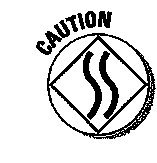
Jacks are used only to get a vehicle off the ground. They should never be used to hold a vehicle in place. Even if you’re simply changing a tire, you need to make sure that you’ve blocked the other wheels so that the car doesn’t roll off the jack. You must use jack stands when you work underneath your car; if you don’t, you run the risk of serious injury or even death. People have been crushed to death when vehicles that were improperly secured fell on them.
Before you attempt to jack up your vehicle, observe the following safety precautions:
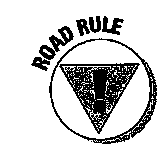
Never change a tire on a freeway or highway.
Not only can you be seriously injured, but you can also fall prey to carjackers. Don’t exit the car on the side nearest traffic; use a cellular phone to call road service or the AAA. If you have no cellular phone and a public phone isn’t near enough to make a call and get right back into your car, hang a white rag or a white piece of paper out of the driver’s side
window and wait for the highway patrol to rescue you.
Always park a vehicle on level ground before you jack it up.
If you get a flat tire on a hill and can’t coast to the bottom without killing the tire completely, then park close to the curb, turn the wheels toward the curb, and block the downside wheels securely to prevent the car from rolling. Even after taking these precautions, however, I’d be nervous.
Never jack up a vehicle without blocking the wheels.
Even if the car is on level ground, use bricks, wooden wedges, or metal wheel chocks to block the wheels at the opposite end of the car from the end that is to be raised. Doing so keeps the vehicle from rolling after it has been jacked up.
Keep the blocks in the trunk of your car so that you won’t have to go hunting around if you have to change a tire when you’re away from home.
If you find yourself faced with the job of changing a tire and you have nothing with which to block the wheels, park near the curb with the wheels turned in. This may not keep you from getting hurt if the car rolls off the jack, but at least innocent motorists and pedestrians won’t have to deal with a runaway driverless car!
Be sure that your gearshift is in Park (or in First if you have a manual transmission) and that the emergency brake is on before you jack it up. The only time you don’t want the emergency brake on is when you have to be able to rotate a rear wheel or remove rear brake drums to inspect the brakes. In such a case, make sure that the front wheels are blocked securely, preferably with chocks designed for the purpose. (Chocks are available at a low cost at auto supply stores, and they stow neatly in the trunk.)
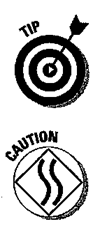

Once you’ve observed the safety precautions just listed, follow these steps:
1. If you’re going to remove a wheel to change a tire or check your brakes, remove the hubcap (If there is one) and loosen the lug nuts before you jack up the car.
Once the car is jacked up, the wheel will turn freely, which makes getting a hubcap off harder and makes starting the nuts almost impossible. Instructions for removing a hubcap and loosening lug nuts are in the next section, “How to Change a Tire.”
2. Place the jack under the part of the vehicle that it should contact when raised. If you are using jack stands, place them near the jack.
Where you place your jack depends on whether you’re planning to do a one-wheel job, such as tire changing or brake checking, or a two-wheel, whole-end repair job. To find out the proper place to position the jack for your particular vehicle, check your owner’s manual. If you have no manual, ask the service department at your dealership to show you the proper place, or follow these rules:
Never place the jack so that the weight of the vehicle rests on something that can bend, break, or give. If your manual is incomprehensible or lacks this kind of information, try to place the jack so that it touches either the car frame or the big bar that supports the front wheel suspension. You can also place jacks near the rear-wheel axle. Until you become more proficient at this, I’d stick to jacking up one wheel at a time. It may mean more work, but the practice is good for you.
3. Lift the vehicle by using the jack. How you accomplish this depends on the type of jack you’re using (see Figure 1-1):
• If you have a hydraulic jack, place the handle into the appropriate location and pump up and down. Use nice, even strokes, taking the jack handle from its lowest to its highest point on each stroke to cut down on the labor involved.
• If you have a tripod jack, turn the crank.
• If you have a scissor jack, insert the rod or wrench over the knob and then crank.
Figure 1-1: The type of jack you have determines whether you crank, turn, or pump.

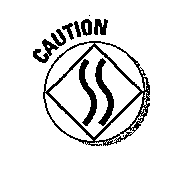
4. If you have jack stands, place them under the car, near the place where the jack is touching the vehicle (see Figure 1-2). Raise the stands until they are high enough to just fit under, and lock them in place. Lower the jack until the car is resting on the jack stands. Then remove the jack.
Substituting boxes, stones, or bricks for jack stands is very dangerous. They can slip out or break while you’re under the car. A jack can do the same thing, so if you’re going to work under your car (and you will if you plan to change your own oil and do your own lube jobs), be sure to buy a pair of jack stands. The money you save by getting under there yourself will pay for the stands in no time. You can find information about buying jack stands in Chapter 2.
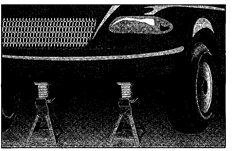
Figure 1-2:
Jack stands hold your vehicle up safely.
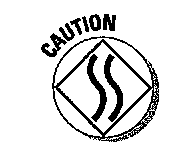
5. Before you begin to work, wiggle the car a little to make sure that it’s resting securely on the jack or the jack stands.
Doing so also tells you whether you have the wheels blocked properly. It’s better if the vehicle falls while all four wheels are in place. (It will bounce just a little.)
If you remove a wheel and begin to work without making sure that you jacked up the car and blocked it securely, it can do a lot of damage to itself — and to you — if it falls. (This is not meant to frighten you away from jacking up your car and working on or under it. It’s just to emphasize the fact that a few simple precautions will remove any danger.)
6. When you’re finished working, lower the vehicle to the ground.
If you’re using a tripod or scissor jack, simply turn the crank in the opposite direction. If you’re using a hydraulic jack, use the rod to turn the pressure release valve. The jack will do the rest of the work for you.
